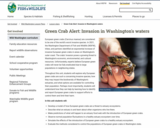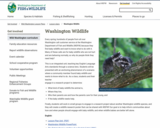
European green crabs (Carcinus maenas) are considered to be one of the world’s worst invasive species. In 2021, the Washington Department of Fish and Wildlife (WDFW), tribes, and partners identified an exponential increase of invasive European green crabs in areas on Washington’s outer coast. The crabs' invasion poses a growing threat to Washington’s economic, environmental, and cultural resources. Unfortunately, experts believe European green crabs will never be fully eradicated due to large populations in neighboring states.
Throughout this unit, students will explore why European green crabs are such a concerning invasive species, how they may impact the biodiversity of Washington’s estuaries, and what options are available for controlling their population. Perhaps most importantly, students will understand how they can help by learning how to identify and report European green crabs to support efforts to control them and limit their harm.
In this unit students will:
Develop a model of how European green crabs are a threat to estuary ecosystems.
Describe what an estuary is and learn about other organisms who live there.
Make predictions of what will happen to an estuary food web with the introduction of European green crabs.
Observe normal population fluctuations in a healthy estuary ecosystem over time.
Simulate the effects of the introduction of European green crabs to a healthy estuary ecosystem.
Evaluate the methods considered to control the populations of European green crabs in Washington state.
This mini unit is designed to be able to stand alone, or to supplement OpenSci Ed unit 7.5 Ecosystem Dynamics: “How does changing an ecosystem affect what lives there?”. To ensure this unit is easily implemented, the unit has been designed to replicate the processes and procedures utilized by OpenSci Ed.
- Subject:
- Applied Science
- Computing and Information
- Environmental Science
- Life Science
- Material Type:
- Activity/Lab
- Homework/Assignment
- Lesson Plan
- Unit of Study
- Provider:
- Washington Department of FIsh and Wildlife
- Author:
- Washington Department of Fish and Wildlife
- Date Added:
- 09/10/2024
